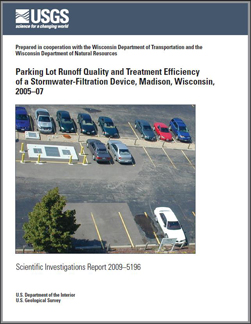Scientific Investigations Report 2009–5196
Abstract
To evaluate the treatment efficiency of a stormwater-filtration device (SFD) for potential use at Wisconsin Department of Transportation (WisDOT) park-and-ride facilities, a SFD was installed at an employee parking lot in downtown Madison, Wisconsin. This type of parking lot was chosen for the test site because the constituent concentrations and particle-size distributions (PSDs) were expected to be similar to those of a typical park-and-ride lot operated by WisDOT. The objective of this particular installation was to reduce loads of total suspended solids (TSS) in stormwater runoff to Lake Monona. This study also was designed to provide a range of treatment efficiencies expected for a SFD. Samples from the inlet and outlet were analyzed for 33 organic and inorganic constituents, including 18 polycyclic aromatic hydrocarbons (PAHs). Samples were also analyzed for physical properties, including PSD. Water-quality samples were collected for 51 runoff events from November 2005 to August 2007. Samples from all runoff events were analyzed for concentrations of suspended sediment (SS). Samples from 31 runoff events were analyzed for 15 constituents, samples from 15 runoff events were analyzed for PAHs, and samples from 36 events were analyzed for PSD. The treatment efficiency of the SFD was calculated using the summation of loads (SOL) and the efficiency ratio methods. Constituents for which the concentrations and (or) loads were decreased by the SFD include TSS, SS, volatile suspended solids, total phosphorous (TP), total copper, total zinc, and PAHs. The efficiency ratios for these constituents are 45, 37, 38, 55, 22, 5, and 46 percent, respectively. The SOLs for these constituents are 32, 37, 28, 36, 23, 8, and 48 percent, respectively. The SOL for chloride was −21 and the efficiency ratio was −18. Six chemical constituents or properties—dissolved phosphorus, chemical oxygen demand, dissolved zinc, total dissolved solids, dissolved chemical oxygen demand, and dissolved copper—were not included in the efficiency or SOL, because the difference between concentrations in samples from the inlet and outlet were not significant. Concentrations of TP and TSS were inexplicably high in samples at the inlet for one event. |
Posted May 7, 2010 For additional information contact: Part or all of this report is presented in Portable Document Format (PDF); the latest version of Adobe Reader or similar software is required to view it. Download the latest version of Adobe Reader, free of charge. |
Horwatich, J.A., and Bannerman, R.T., 2010, Parking lot runoff quality and treatment efficiency of a stormwater-filtration device, Madison, Wisconsin, 2005–07: U.S. Geological Survey Scientific Investigations Report 2009–5196, 50 p.
Abstract
Introduction
Design of the Stormwater-Filtration Device
Methods
Treatment Efficiency of the Stormwater-Filtration Device
Summary
Acknowledgments
References Cited
Appendix 1. List of References for Previous Investigations
Appendix 2. Tables of Sample Analyses Results